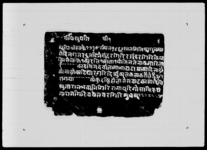A copperplate inscription recording the emancipation of three women from slavery by Sundara Giri and his wife (VS 1869)
ID: PN_0004_0065
Edited and
translated by Manik Bajracharya
Created: 2016-12-05;
Last modified: 2018-06-15
For the metadata of the document, click here
The accompanying edition, translation/synopsis and/or commentary are available under the terms of the Creative Commons Attribution-ShareAlike 4.0 International License
Abstract
Sundara Giri and his wife emancipate three women slaves named Lakṣmi, Koili and Jvālā at the entrance of the Paśupati temple.Diplomatic edition
[1r]
श्री\श्रीपसुपति1स्वस्तिश्रीसाके१७३४संम्वत१८६९सालमितिफागुनमा2सेदिनगत२६तदिनेसूंदरगिरिरसूंन्दरगिरिकिस्वा
3स्निले:लक्ष्मि१कोइलि१ज्वाला१योतिनजनाकमारिला
4ई ¯ ¯ ¯ ¯ ¯ ¯ ¯कादषिन्दर्वाजामाभादाटाम्वाकादिन:दो
5कोनाम्लोकाटिपारगरिदिञ्युं:कालकलाकसैलेझैझग
6रागर्या ¯ ¯ ¯ ¯ ¯ ¯ ¯कोकुदष्टिहोलातेसवाटकासाछिवि
7ष्णुनारानभवानिगिरिरामापूरिगोसाञि:रूप
8नारानगिरि:वषतवरगिरिशुभम् ¯ ¯ ¯ ¯ ¯ ¯ ¯
Translation
[1r]
Glorious Paśupati
Hail! On the 26th solar day of the month of Phālguna in the Śaka year 1734 and the [Vikrama] era year 1869 (1813 CE), we, Sundara Giri and Sundara Giri's wife, have freed these three female slaves—Lakṣmi, Koili and Jvālā—by giving copper utensils at the southern door of --- [i.e., glorious Paśupati],1 and by cutting off the ḍoko [from] the nāmlo.2 If anyone creates a dispute at a [future] point in time (kālakalā),3 he will be struck with the evil eye of --- [i.e., glorious Paśupati]. The witnesses to this act are: Viṣṇu Nārāna, Bhavāni Giri, Rāmā Purī Gosāñi, Rūpa Nārāna Giri [and] Bakhatavara Giri. Auspiciousness.
Commentary
This is a copperplate dating to 1813 found at the Paśupati temple. The text on it records formal measures a certain Sundara Giri took to free three female slaves. Interestingly, the document mentions that during this ceremonial act, Sundara Giri offered some copper utensils and cut off a carrying strap (nāmlo) from its basket basket (ḍoko), perhaps as a symbol of the laborious work the slaves no longer had to carry out. Maske 1996: 34 mentions of this ceremonial procedure, referring to a document of 1877 from Foreign Political A of the National Archives of India: "The slave takes a Dhoka (doko) or basket on his or her back with a goat in it, and the master cuts and (sic!) band by which the Dhoka is held, and which passes round the forehead of the carrier. The slave is then free."
The document lists five persons as witnesses to the act. The donors and the witnesses mentioned in the document belong to the daśanāmī order.
For another document regarding the freeing of slaves at the Paśupati temple, see PN_0002_0030.

